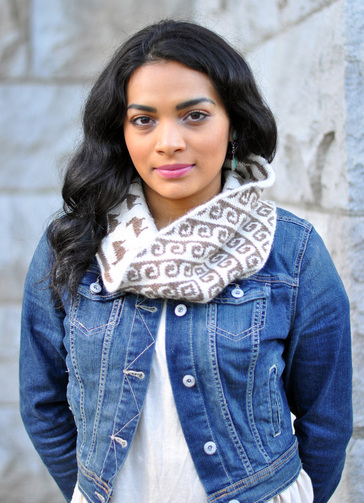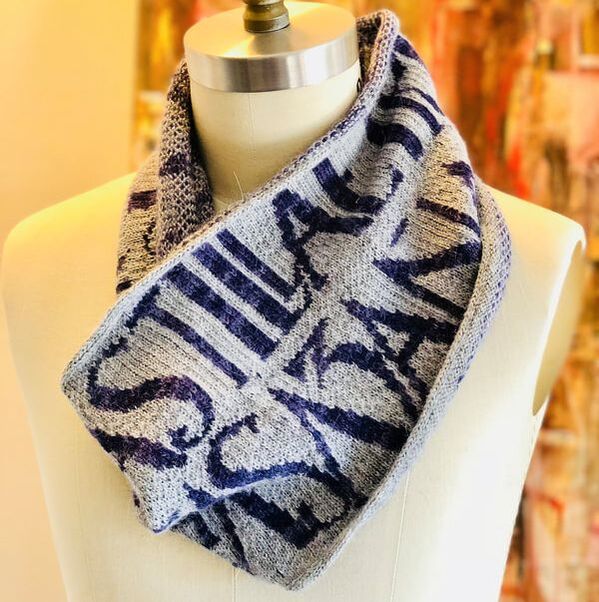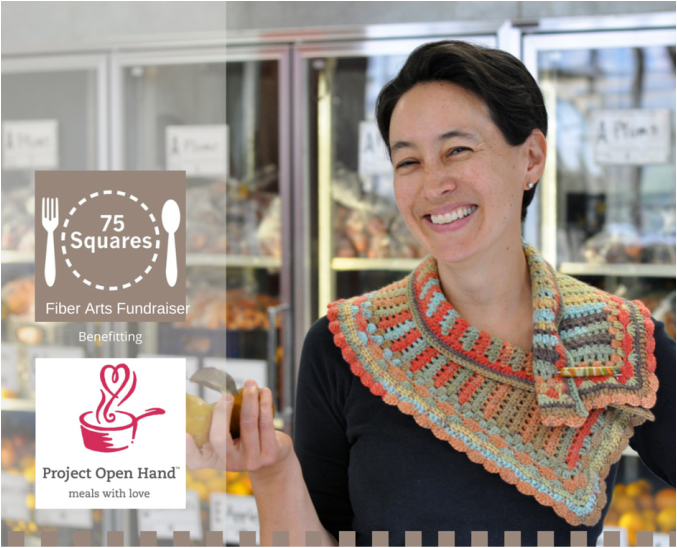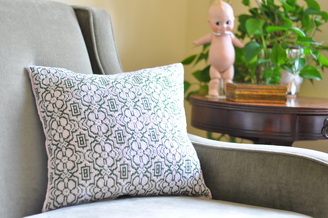|
The I-cord cast on is one of my favorites. Yes, it takes a bit of time but I promise it is time well invested. The edge is a fun tube that has a bit of structure to it, and it works so well with built-in i-cord edges. Why do I love this cast on so much?
You've never tried the i-cord cast on? Here's a video that demonstrates how to do it! While casting on, I do think about the song One Step Forward by Desert Rose Band - in case you also need audio encouragement! OK! Now that you know how to do the i-cord cast on, what might you make with it? You will find it in a variety of projects, generally ones where the edge of the fabric doesn't need much stretch. Here are a few of my patterns that feature the i-cord cast on as the opening number:  My latest pattern, Maras, was inspired by a linoleum floor I saw during a trip to the Sacred Valley in Peru. It's a dynamic, repeatable design that translated into the most amazing of wraps. Worked in the new yarn Roslyn from Cascade, (65% wool, 35% silk) it's so drapey and lovely. The pattern utilizes the technique of locked floats, which makes the back of the piece appear almost woven. Members of TKGA have access to this pattern in the latest issue of CAST ON Magazine (Winter 15/16). Sign on to the TKGA website HERE and join/download/cast on! Happy Knitting, Kyle It's time to buy with heart! We have over 30 different handmade pieces listed in the 75 Squares fundraiser! Each one is $150.00, and that donation is enough to serve 75 meals to those in need.
Click the image or HERE to be directed to the shop. Here's to helping others! Kyle I had the best time spending the day with this great group of women at Bay Area Cancer Connections in Palo Alto,CA. Each one is either supporting a friend or on her own journey facing cancer. The learn to knit workshop was a success and they are all well on their way to making a hat of their very own. It sounds like they may begin an informal knitting group at the Center! Many thanks to those who donated materials, including Erin Lane Bags, Kollage, Brittany, Skacel, and HiyaHiya! Thanks also to my friend Darin who helped out all day.  It all starts with yarn. In this case, I was enamored by the random craziness and color-changing fun of "Crazy" by Stonehedge Mill. My goal was to create an interesting (but not overly complicated) project that would show off this unique product. I'm really pleased with the result. the pattern isn't difficult to knit, and the finished cowl is visually interesting. I'm not sure which part is more appealing; the color shifting yarns or the angled stripes. Either way, it's a cowl that I enjoyed making and am excited to share with you. Is it a difficult pattern? Not at all. In fact, I found it to be perfect for knit night and tv watching. The color changing yarns kept cheering me on as I worked, and I found that a lot of progress was made each time I sat down to work. With this truly random yarn you have no idea what the next row will look like! The pattern is available as a .pdf download HERE for $4.00. It requires techniques including provisional cast on, knit/purl, increase/decrease, following a simple chart, kitchener stitch, and applied i-cord.
During the past few weeks two of my projects have been released. A magazine article and a knitting pattern: In the Autumn 2014 issue of Ply Magazine, I write about spinning, and the Men's Knitting Retreats. (and of course, as I try to write here about the article, I realize how difficult it is to write about writing!) haha Also, the latest Cast On magazine features my latest pattern, Thara. This is a fun colorwork cowl that was inspired by Thai weaving.
The studio continues to buzz with activity. Working hard on the book, and I have a few other designs clicking their way through the process on their way to publication. This fall promises to be busy, and I'm looking forward to moving through the "to do" list that's filled with such exciting things! KW  It has been a while since I posted a tutorial video, and it seems like this is a great place to share with you how to lock floats in knitting. The technique has been explored by a number of people, including Meg Swansen and Joyce Williams in the book Armenian Knitting. One of my sample knitters, Cindy Baily, encouraged me to give it a try and I've been locking floats ever since. I promise you that it becomes really easy with practice. Yes, it slows me down just a touch while working, but it certainly makes the inside of a finished garment so beautiful. Sometimes this technique will cause the floated yarn to "peek" through to the front of the fabric. Yarns with more "spring" work better for this technique, and while I'm swatching I work with different needle sizes to discover the best combination of yarn, needles, and pattern. Here's hoping you are having a beautiful week! Kyle  The inspiration for the Aymara cowl arrived the day I saw Jorge del Carpio's Kickstarter campaign for Fibras Andinas. I read the story of the Chilean herders tending their flocks 11,000 ft above sea level, and learned how the development of this new project would provide an opportunity for the purchase and use of the fiber from the animals. Over the next few months, I exchanged emails with Jorge and learned even more about his passion for helping his community. Once Nicole Snow from Darn Good Yarn joined on as the U.S. distributor, it was decided: I was going to design something special with this yarn. The outside of the cowl is inspired by traditional Aymara weaving patterns, and the inside features round after round of adorable llamas! It's knit on circular needles, and the beginning and end are grafted together hiding all ends and making the entire piece reversible and oh-so-cozy. This project takes two skeins each of 2 colors of sport weight yarn from Royal Llama (available in the United States via Darn Good Yarn). Is it soft, you ask? Most definitely. The fiber is de-haired llama. It's warm, luxurious, amazing to work with, and wearing the finished cowl is like getting a big hug from a long-lost friend. Of course, another benefit is knowing that your purchase of Royal Llama yarn helps support the Chilean llama herders! Skills needed | Provisional cast on, knit, purl, working in the round, stranded color work, Kitchener stitch. You will find the pattern on Ravelry HERE. The pattern will be available in a kit available through Darn Good Yarn and Fibras Andinas. Aymara is available in English & Spanish as an individual pattern (via the link below): $4.00
This is the second time I have had the pleasure of designing for Quince and Co.! This year I wanted to design a cowl that was simple enough for someone just venturing into the world of lace. Reversible, without being overly-complicated. A weekend of swatching and pondering yielded this new design. Araminta requires basic knitting knowledge, including working in the round, increasing/decreasing, and finishing. Know how to knit, purl, yarn over, do simple decreases? Know how to do a twisted knit stitch? That's about all you need to know to make this cowl! ...And for those who have yet to work with Quince and Co. yarn, I encourage you to visit your LYS or order some online and give it a try. The colors are beautiful, and this particular yarn is soft, rustic, and familiar.  Of course, once you have the entire 14 pattern collection, it'll be hard to decide what to make first. There are options! Colorwork, cables, lace, pleats, asymmetrical wraps... the list goes on and on! All the photography is stunning (as usual). It, along with the e-book layout is done by the uber-talented Carrie Bostick Hodge. The yarn, I should say, is lovely. Owl is a favorite of mine because of its rustic feel. Not only does it work well with twisted stitches, it makes cables sing! Just a few weeks ago, Quince and Co. announced Owl Tweet! - the tweed version of Owl. I saw it at Stitches WEST and loved it. Perhaps someone will work Araminta in Tweet so I fall in love all over again. I designed the Modern Motif Pillow for Universal Yarn's new book: Nazeli Garden 5: Bring Your Garden Inside. The book contains 18 designs for the home. One side is covered in a floral motif and the opposite side uses a geometric design created after studying Georgian era garden plans. Before sending the samples out to the publisher I took a few photos, and Dewey wanted to join the fun! He's so adorable I had to share one of those too. The entire piece is worked in the round, and is finished with applied i-cord and sealed with a zipper.
The project is worked in the round and requires basic knitting knowledge, including knit/purl, i-cord, and finishing, including the installation of a zipper. Learn more about the project HERE or visit the Ravelry page HERE. |
Archives
July 2023
Categories
All
|
ExploreFor Fun
|
Support |
Connect |
© 2006-2023 Kyle William. All Rights Reserved.



















 RSS Feed
RSS Feed
